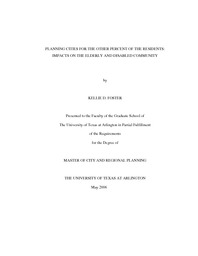| dc.contributor.author | Foster, Kellie D. | en_US |
| dc.date.accessioned | 2007-08-23T01:56:30Z | |
| dc.date.available | 2007-08-23T01:56:30Z | |
| dc.date.issued | 2007-08-23T01:56:30Z | |
| dc.date.submitted | May 2006 | en_US |
| dc.identifier.other | DISS-1345 | en_US |
| dc.identifier.uri | http://hdl.handle.net/10106/334 | |
| dc.description.abstract | The urban environment has evolved in the time since the Second World War. Advances in technology have been a catalyst for numerous urban problems; urban sprawl, poverty and a shortage of low to moderate-income housing, for example. When addressing these issues, city planners often neglect the needs of the disabled community. This is cause for concern because society is aging and due to advancements in medicine, the disabled population is growing exponentially.
The focus of this thesis is the roll urban design and city planning has in the issues that plague the disabled community by examining both physical design and the policies that affect their social interaction and status. Furthermore, a study of how this
information can be used to create better standards and policies to prevent a crisis in the future. | en_US |
| dc.description.sponsorship | Anjomani, Ardeshir | en_US |
| dc.language.iso | EN | en_US |
| dc.publisher | Urban & Public Affairs | en_US |
| dc.title | Planning Cities For The Other Percent Of The Residents: Impacts On The Elderly And Disabled Community | en_US |
| dc.type | M.C.R.P. | en_US |
| dc.contributor.committeeChair | Anjomani, Ardeshir | en_US |
| dc.degree.department | Urban & Public Affairs | en_US |
| dc.degree.discipline | Urban & Public Affairs | en_US |
| dc.degree.grantor | University of Texas at Arlington | en_US |
| dc.degree.level | masters | en_US |
| dc.degree.name | M.C.R.P. | en_US |
| dc.identifier.externalLink | https://www.uta.edu/ra/real/editprofile.php?onlyview=1&pid=1119 | |
| dc.identifier.externalLinkDescription | Link to Research Profiles | |

